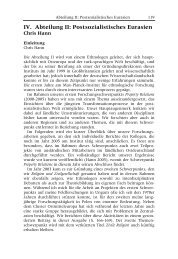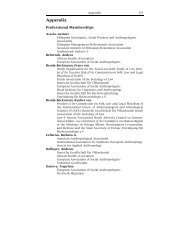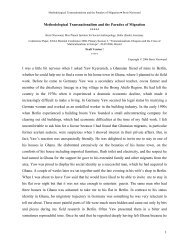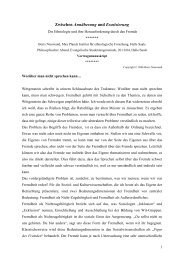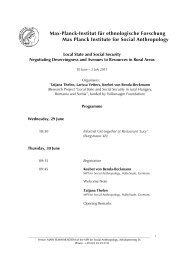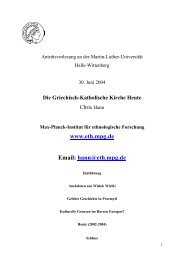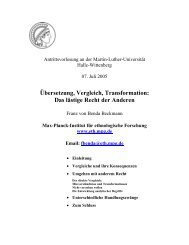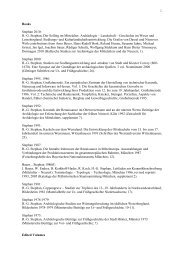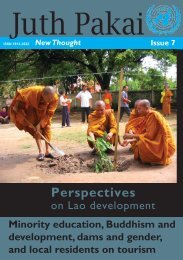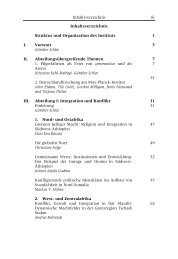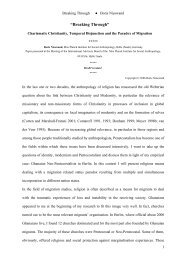ETHNOPOLITICS AND GAbRA ORIGINS - Max-Planck-Institut für ...
ETHNOPOLITICS AND GAbRA ORIGINS - Max-Planck-Institut für ...
ETHNOPOLITICS AND GAbRA ORIGINS - Max-Planck-Institut für ...
Create successful ePaper yourself
Turn your PDF publications into a flip-book with our unique Google optimized e-Paper software.
Tana 26 speaking ancestors of the Arbore, and boundaries between Boran and Arbore branches of<br />
the same clans had not yet crystallised.<br />
More support for the importance of the Arbore for a truly regional picture that goes beyond rival<br />
accounts of Oromo and Somali influences can be derived from Ayalew (1995) 27 . He brings the<br />
Karrayyu of Shoa into play (Ayalew 1995: 55), whose connections to the Karrayyu clan of the<br />
Boran would also need to be explored. He states that the Olmok of Gandareb village and the Hiruf<br />
of Kulaama both trace their origins to the “Oromo Kereyu” (Ayalew 1995: 60). Olmok is the clan<br />
of the junior qawot of the Arbore. Qawot is the Arbore equivalent of qallu. According to Gabbert<br />
(personal communication) and Tadesse (1999: 108), the qawot of Olmok is seen as the equivalent<br />
of the Boran qallu of Karrayyu. Ayalew (1995: 20) reports that the succession ceremony for a new<br />
qawot is always attended by Boran representatives from the equivalent clan.<br />
Kassam attributes the origins of most Gabra lineages to “Rendille” and “Somali,” which is in<br />
perfect agreement with my findings that most of the ancestors of the Gabra at one point were<br />
speakers of a Somaloid language 28 . For the origins more remote in time, I prefer to speak of Proto-<br />
Rendille-Somali to make clear that in these cases the Gabra, of course, do not stem from modern<br />
Rendille or Somali but from earlier layers of Somali-like culture. Apparently Kassam does not see<br />
the need for such a differentiation.<br />
The point that it is unlikely that the ethnic boundaries of the 16th century coincide with the<br />
modern ones, that we do not know whether all or any of the ancestors of the modern Rendille<br />
(Gabra, Sakuye, etc.) who lived then were called Rendille (or Gabra, Sakuye respectively), may be<br />
too obvious to dwell on for long. Insisting on the difference between “Rendille” and “Somali” on<br />
the one hand, and “Proto-Rendille-Somali” on the other, might even be called pedantic. Still, to<br />
neglect this kind of difference leads to anachronisms. And such anachronisms do not just result in<br />
misrepresentations of history but also in political calamities. Under the pressure of the<br />
26 According to Hayward (1984: 37) the Arbore and the closely related Elmolo together with Dasenech form<br />
the western branch of the Omo-Tana. These languages differ in a number of features from the collateral<br />
eastern branch which comprises Rendille, Boni, and Somali. As Hayward is concerned with the classification<br />
of Arbore, he does not elaborate on the precise relationships within this eastern branch. As the internal<br />
differentiation between variants of “Somali” is as wide as that between “Somali” and Rendille, this tripartite<br />
division, is, of course, a simplification. The eastern branch of Omo-Tana, however, clearly comprises all<br />
those I have termed speakers of Somali-like or Somaloid languages including the early bearers of the PRS<br />
complex of cultural features. All these are thus set apart from the Arbore, whose language is located on a<br />
different branch of Omo-Tana. The level of difference to Oromo is yet higher. Both the Omo-Tana language<br />
and Oromo are Eastern Lowland Cushitic on a higher level of classification. But even in this wider subfamily,<br />
structural similarities are so considerable that any one language can easily be learned on the basis of<br />
any other.<br />
Much needs to be explored about the cultural relationships between the Arbore and the PRS derivates to the<br />
south of them. I certainly would not subsume them under the label PRS, but if linguistic similarities can be<br />
accepted as a basis of informed guesses in the absence of data on other domains of culture, the Arbore can be<br />
related to the groups I have described as deriving form the PRS cluster, but not as closely as the latter are to<br />
each other. Although in my work I refer to the Arbore repeatedly (Schlee 1989: 32, 158, 177, 185, 188–9,<br />
201), much of the evidence is indirect and did not satisfy me.<br />
Since then, Tadesse Wolde (1999) has thrown some light on the Arbore and now all our expectations are<br />
directed towards the on-going research by Christina Gabbert.<br />
27 This MA thesis reflects an early stage of Ayalew’s work and might require some cross-checking. It is to be<br />
hoped that Ayalew continues with this highly interesting line of research.<br />
28 In view of her emphasis on a “regional” perspective, it is, however, strange that she bases her argument<br />
overwhelmingly on (uncited) Gabra sources. To the best of my knowledge, of the relevant languages she only<br />
speaks Boran, the language of the Gabra. Her statements about other groups are limited to Gabra claims to<br />
derive from them: Such and such a lineage comes from Rendille, another one from “Somali”. She has not<br />
investigated these claims from the Rendille or Somali side, does not discuss contradictions, variants,<br />
ideological forces. The truly “regional” chorus of voices cannot be perceived through her writings.<br />
9



